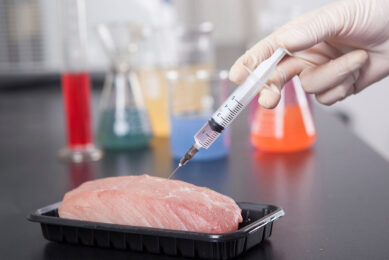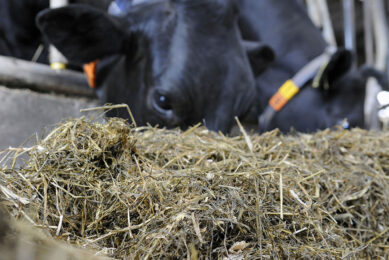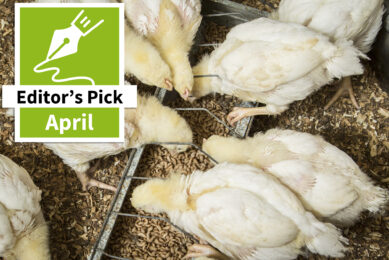Ways to optimise rumen fermentation
![Cows may experience a negative energy balance after calving. Adding live yeast to the diet in the pre-partum period might help. [Photo: Michiel Zoeter]](https://www.allaboutfeed.net/app/uploads/2020/12/001_820_rb-image-2695430.jpeg)
The rumen is the most influential site of digestion and microbial fermentation provides much of the energy needed to maintain body condition, pregnancy and lactation. Feeding a live yeast additive can benefit the rumen environment and its microbes.
In terms of diet, energy is often the primary driver for milk yield and producers have looked to various types of ingredients, such as fats and starch, as well as some by-pass products, to deliver more energy through the diet; the idea of the latter being to avoid manipulation in the rumen and deliver an energy source direct to the small intestines. The draw-back to these can often be a substantial increase in diet cost, as well as overlooking the fact that the cow is a ruminant and should be fed as much as possible. As discussed previously, a healthy rumen promotes production efficiency so optimising rumen function should be a priority over other tools to support milk production.

The effects of live yeast
Whilst the basic rules of feeding apply, there are ingredients available that can facilitate good rumen function. Dietary inclusion of live yeast can rapidly promote an anaerobic environment helping desirable, fibre-digesting microbes to proliferate and efficiently colonise feed particles, resulting in lower rumen lactate concentrations, higher overall pH and a reduced risk of acidosis. A certain live yeast* (a proprietary strain of the live yeast Saccharomyces cerevisiae) is known to work by metabolising excess oxygen entering the rumen present via feed particles. Supplementation with this live yeast has demonstrated increased numbers of live rumen bacterial cells compared with unsupplemented animals.

Improvement in feed conversion efficiency (FCE)
One consistent measurable with the addition of this yeast additive is an improvement in feed conversion efficiency (FCE) defined as the kilogram of milk produced for every kilogram of dry matter intake (DMI). Improved rumen fermentation increases energy delivery to the cow, resulting in significantly better milk yields. In a recent meta-analysis of the efficacy of live yeast in ruminant diets, supplementation with yeast increased DMI, rumen pH, volatile fatty acid (VFA) production and organic matter digestibility, as well as decreasing rumen lactate concentration. As a result, milk yield increase with a tendency to increase milk fat (58% of the trials included used the above mentioned live yeast product). However, in this study, trials with all ruminant species at all physiological stages were considered together. Three European trials each demonstrated increased milk yields (Figure 2). In all trials, FCE was increased (by 6.6%, 6.3% and 5.1% for Germany, Estonia and Ireland, respectively).
Dealing with energy balance
The energy balance of a cow determines its metabolic activity and is a key determinant of milk production and fertility. When a cow is in negative energy balance (NEB), its metabolic status is impaired, leading to low reproductive performance. The transition and early lactation periods have been identified as the times when a cow is at most risk of being in NEB due to calving and preparation for lactation, coupled with the typically lower DMI, all of which leads to an increased rate of mobilisation of body reserves. Cows that have been overfed prior to calving may experience a greater drop in intake, leading to a more severe NEB. Such an imbalance can lead to an increase in days to first ovulation post-partum and poor conception rates, as well as fatty liver syndrome, lower milk production, impaired immunity, ketosis and impaired hormone production and return to oestrus. Providing sufficient energy in the transition period despite the lower DMI can go a long way to reducing NEB suffered by the cow shortly post-partum. This limits adverse metabolic and hormonal effects that are associated with poor fertility and loss of production performance.

Reduction in plasma non-esterified fatty acids (NEFA)
Dietary inclusion of YEA-SACC during the pre-partum period resulted in, not only a numerical increase milk yield (see also Table 1 at bottom of article) but a concomitant reduction in plasma non-esterified fatty acids (NEFA) associated with NEB. The lower levels in yeast-fed cows indicated a lower requirement for mobilisation of body reserves following increased energy supply from the diet. Reduced mobilisation would result in improved liver function, associated with a lower risk of ketosis. When cows were monitored for fertility parameters, animals fed a live yeast additive achieved first oestrus post-calving an average of six days earlier compared with control cows. These results were mirrored in a study by Alibrahim et al. (2010), albeit non-significantly.
Conclusions
Maintaining adequate energy levels in transition, calving and early lactation periods in dairy cows is essential to maintain milk yields and quality, body nutrient reserves, liver function and return to oestrus. Adding extra dietary by-pass nutrients can be a solution but this should only be done when the diet does everything it can to optimise rumen fermentation. Trials carried out with the specialist live yeast supplement have demonstrated the benefits of healthy rumen function and microbial balance, resulting in greater dietary energy release. As such, live yeast helps to reduce the risk severe NEB thereby reducing the problem of excessive fat mobilisation from body reserves and the associated liver dysfunction. The result is a faster return to oestrus post-calving and increased rates of first conception.
*YEA-SACC. References are available on request.
Join 26,000+ subscribers
Subscribe to our newsletter to stay updated about all the need-to-know content in the feed sector, three times a week. Beheer
Beheer









 WP Admin
WP Admin  Bewerk bericht
Bewerk bericht